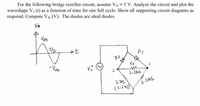
Introductory Circuit Analysis (13th Edition)
13th Edition
ISBN: 9780133923605
Author: Robert L. Boylestad
Publisher: PEARSON
expand_more
expand_more
format_list_bulleted
Question

Transcribed Image Text:For the following bridge rectifier circuit, assume Vm = 5 V. Analyze the circuit and plot the
waveshape Vo (t) as a function of time for one full cycle. Show all supporting circuit diagrams as
required. Compute Vde (V). The diodes are ideal diodes.
Võ
Vm
The
PI
D2
Vo
- Vm
2. 2h2
2-22
(2.2ks)
2.212
Expert Solution
This question has been solved!
Explore an expertly crafted, step-by-step solution for a thorough understanding of key concepts.
Step by stepSolved in 4 steps with 6 images

Knowledge Booster
Learn more about
Need a deep-dive on the concept behind this application? Look no further. Learn more about this topic, electrical-engineering and related others by exploring similar questions and additional content below.Similar questions
- Q5- What is the advantage of the Zener diode ?arrow_forwardIt is required to design full-wave rectifier circuits. Consider the rectifier circuits shown in figures (a) center-tapped rectifier, (b) bridge rectifier. Assume the input voltage is from 120V(rms), 60HZ ac source. The desired peak output voltage vo is 10V. A conducting diode has a voltage drop of 0.7V. In each case, (i) Determine the required turns ratio of the transformer; (ii) Determine the required peak inverse voltage (PIV) of the diodes. D, Center tap R. D. ac line line voltage R voltage D (b) (a) Ans: (1) Turns Ratio (ii) PIV Center tapped Center tapped_ Bridge Bridgearrow_forwardH.W4 The diode in the single-phase half wave rectifier has a reverse recovery time of tr frequency = 5 kHz. 150usec and the source voltage V₁ = 200V at Calculate the average output voltage. EParrow_forward
- Q-2: The input signal for half-wave rectifier is a.c. signal. The output of 800 load resistor is 50V d.c. voltage. The diode has a resistance of 25 Q. 5 a) Draw the graphs of input signal, diode signal and output signals. 20 b) Calculate the maximum voltage value for the input signal. AC Supply Diode wwwarrow_forwardTopic: Half Wave Rectificationarrow_forwardIn terms of polarity, the output of a full-wave rectifier has both alternations of the sine wave input voltage going in the direction. What is the main advantage of full-wave rectifier over the half-wave rectifier? The main advantage of the bridge rectifier over the standard full-wave rectifier is that it does not require a transformer. When one of the diodes in the bridge circuit opens, one of the will be missing at the output. From the data, what conclusion can you draw about the relationship between the dc voltage across R. and peak voltage in a full-wave rectifier?arrow_forward
- One component that does not need to be installed in the correct orientation is a: a. Resistorb. Diodec. Voltage regulatord.arrow_forwardA silicon diode has 1 ampere DC of current in biasd mode. What is voltage drop across the diode?arrow_forwardThe four diodes used in a bridge rectifier circuit have forward resistances which may be considered constant at 1 ohm and infinite reverse resistance. The alternating supply voltage is 220 V r.m.s. and load resistance is 580 ohm. Calculate (i) mean load current and (ii) power dissipated in each diode.arrow_forward
- Answer a,b,c,darrow_forward. A half-wave rectifier is needed to supply 15-V dc to a load that draws an average current of 300 mA. The peak-to-peak ripple is required to be 0.2 V or less. What is the minimum value allowed for the smoothing capacitance?arrow_forwardAnswr all the questions one by one and solve all the unknown values giving all the correct details Let the last digit of the ID = 9arrow_forward
arrow_back_ios
SEE MORE QUESTIONS
arrow_forward_ios
Recommended textbooks for you
 Introductory Circuit Analysis (13th Edition)Electrical EngineeringISBN:9780133923605Author:Robert L. BoylestadPublisher:PEARSON
Introductory Circuit Analysis (13th Edition)Electrical EngineeringISBN:9780133923605Author:Robert L. BoylestadPublisher:PEARSON Delmar's Standard Textbook Of ElectricityElectrical EngineeringISBN:9781337900348Author:Stephen L. HermanPublisher:Cengage Learning
Delmar's Standard Textbook Of ElectricityElectrical EngineeringISBN:9781337900348Author:Stephen L. HermanPublisher:Cengage Learning Programmable Logic ControllersElectrical EngineeringISBN:9780073373843Author:Frank D. PetruzellaPublisher:McGraw-Hill Education
Programmable Logic ControllersElectrical EngineeringISBN:9780073373843Author:Frank D. PetruzellaPublisher:McGraw-Hill Education Fundamentals of Electric CircuitsElectrical EngineeringISBN:9780078028229Author:Charles K Alexander, Matthew SadikuPublisher:McGraw-Hill Education
Fundamentals of Electric CircuitsElectrical EngineeringISBN:9780078028229Author:Charles K Alexander, Matthew SadikuPublisher:McGraw-Hill Education Electric Circuits. (11th Edition)Electrical EngineeringISBN:9780134746968Author:James W. Nilsson, Susan RiedelPublisher:PEARSON
Electric Circuits. (11th Edition)Electrical EngineeringISBN:9780134746968Author:James W. Nilsson, Susan RiedelPublisher:PEARSON Engineering ElectromagneticsElectrical EngineeringISBN:9780078028151Author:Hayt, William H. (william Hart), Jr, BUCK, John A.Publisher:Mcgraw-hill Education,
Engineering ElectromagneticsElectrical EngineeringISBN:9780078028151Author:Hayt, William H. (william Hart), Jr, BUCK, John A.Publisher:Mcgraw-hill Education,

Introductory Circuit Analysis (13th Edition)
Electrical Engineering
ISBN:9780133923605
Author:Robert L. Boylestad
Publisher:PEARSON

Delmar's Standard Textbook Of Electricity
Electrical Engineering
ISBN:9781337900348
Author:Stephen L. Herman
Publisher:Cengage Learning

Programmable Logic Controllers
Electrical Engineering
ISBN:9780073373843
Author:Frank D. Petruzella
Publisher:McGraw-Hill Education

Fundamentals of Electric Circuits
Electrical Engineering
ISBN:9780078028229
Author:Charles K Alexander, Matthew Sadiku
Publisher:McGraw-Hill Education

Electric Circuits. (11th Edition)
Electrical Engineering
ISBN:9780134746968
Author:James W. Nilsson, Susan Riedel
Publisher:PEARSON

Engineering Electromagnetics
Electrical Engineering
ISBN:9780078028151
Author:Hayt, William H. (william Hart), Jr, BUCK, John A.
Publisher:Mcgraw-hill Education,